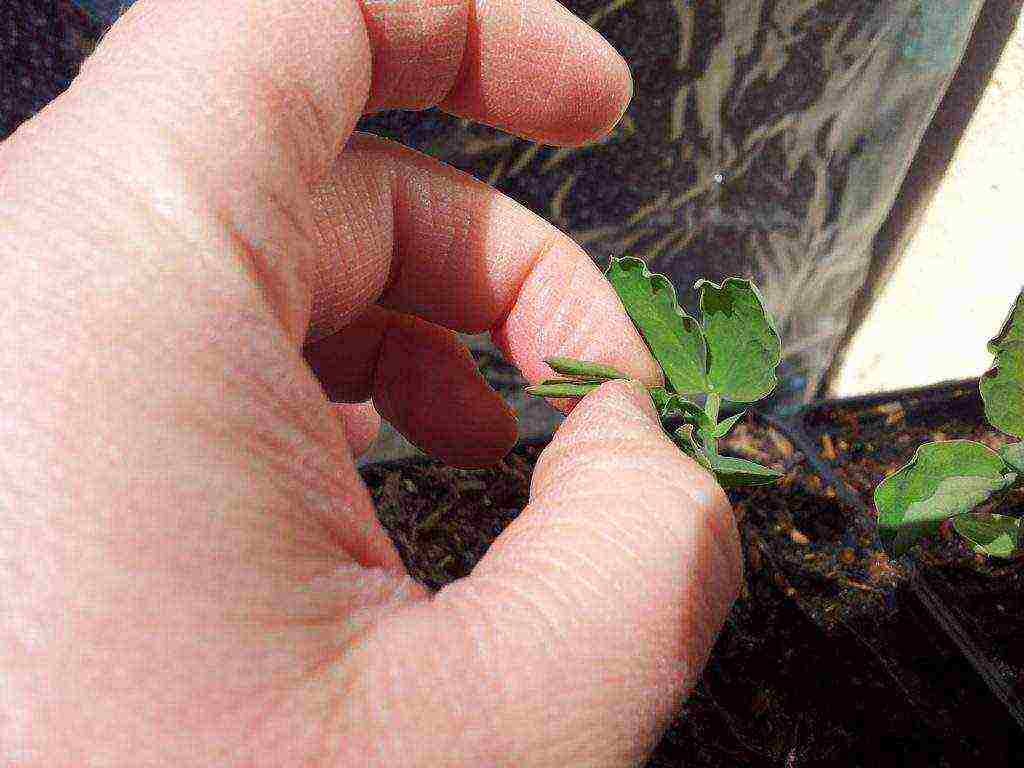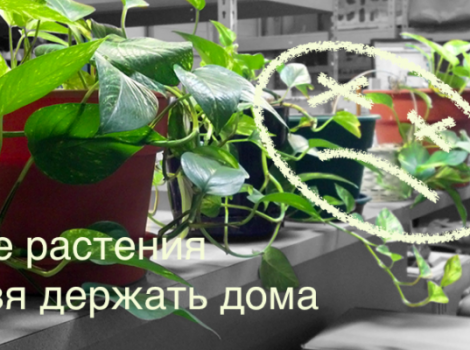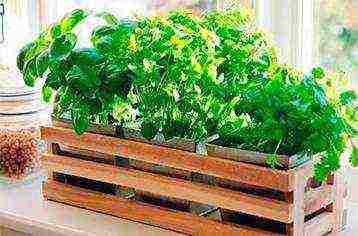Content
- 1 Possible options for garden flowers for the home
- 2 Agricultural rules for gardeners on the window
- 3 Top dressing
- 4 Land preparation
- 5 Secrets of the correct transplant
- 6 What to do in winter?
- 7 Color combination scheme
- 8 Types of flower beds
- 9 Flower garden of continuous flowering of perennials
- 10 How to plant flowers
- 11 Caring for flowers in the garden
- 12 Conclusion
If you are very fond of garden flowers and want to plant them at home, then this can be done, but difficult. Be prepared to use special techniques to speed up flowering times. For example, perennials need to arrange rest periods (as in natural conditions). But if you are patient and carefully study the peculiarities of the flower variety, you will be rewarded with the lush flowering of your garden favorites.
Possible options for garden flowers for the home
Petunias, zinnias, geraniums, dahlias, begonias and marigolds can grow on the window in the house. For the shady side, marigolds, nasturtiums and annual asters are suitable, as well as climbing plants - beans, beans, sweet peas. Both on the shady and on the sunny side, petunias, calendula, cosmea, nasturtiums grow beautifully.
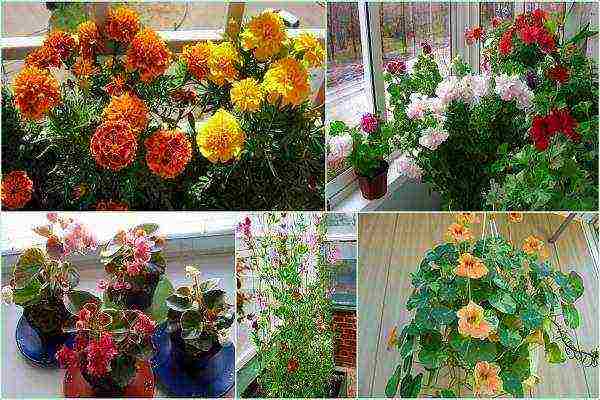
Garden flower options for home growing
In general, you need to select flowers taking into account the light and heat.
|
Side |
Plant |
Description of conditions |
|
South |
Geranium |
They tolerate excess sun. Withstand drought. They do not lose their appearance, do not fade. |
|
Purslane |
||
|
Kobei |
||
|
Aster, dahlias |
||
|
Calendula |
||
|
Phlox, zinnias |
||
|
Cactus |
||
|
Petunias |
On the south side, they must be watered at least 2 times a day. Therefore, add hydrogel to the soil and plant petunias in deep boxes. |
|
|
West and east |
Petunias, nasturtium, marigolds, asters, dahlias, mattiola |
Almost all garden flowers can grow here, except for cacti, which love the sun. It is important that there is bright sun during the day and cool nights. |
|
Levkoy, heather, tobacco, verbena, calendula |
||
|
North |
Fuchsia |
20-25 degrees is enough for her to bloom magnificently. Be sure to need abundant watering. |
|
Begonia |
Loves partial shade, acidic soil, intense watering |
|
|
Balsam, viola, ivy, mignonette, cyclamen |
Viola requires fluctuations between night and day temperatures - think about how you can organize this. It will be easier on the balcony. |
Seeds are planted with calendula, petunias, cornflowers, bulbs - crocuses, tulips and daffodils. The seeds can be simply sown, but the bulbs must be pressed into damp ground, sprinkled, watered and sprinkled again. For tulips to bloom in early March, you need to plant the bulbs in September.
In addition to flowers, it has become fashionable to plant green beds - spices, herbs, such as basil or mint.
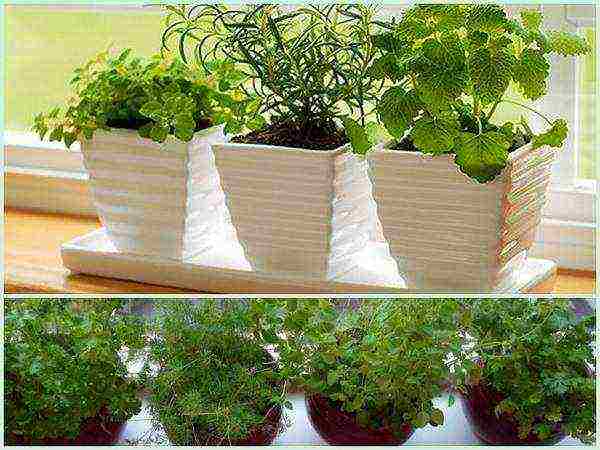
You can grow a spicy garden on the window
Agricultural rules for gardeners on the window
Now breeders are actively developing varieties of garden flowers adapted to growth and flowering on the balcony, windowsill. But in order to take advantage of the fruits of their labor and grow a garden flower bed at home, you need to know about the features of care:
- Regular watering - the amount of soil in the pot is limited, this is not open ground. Therefore, more frequent feeding and watering are assumed.
When dry, chrysanthemums and tulips often crack the stem, azaleas fall off foliage, hyacinths die of shoots, begonia can even shed their buds. And excess water leads to the fact that the roots rot, the leaves begin to turn yellow and the plant dies.
- Good lighting - the garden in the house will lack light a priori, the window glass does not allow all the sun's rays to pass through. From a lack of light, the cuttings rot even at the rooting stage.
Try to keep your garden flowers to the maximum on the balcony, outdoors in the yard, or hang pots from the back of the window (outdoor flower girl).
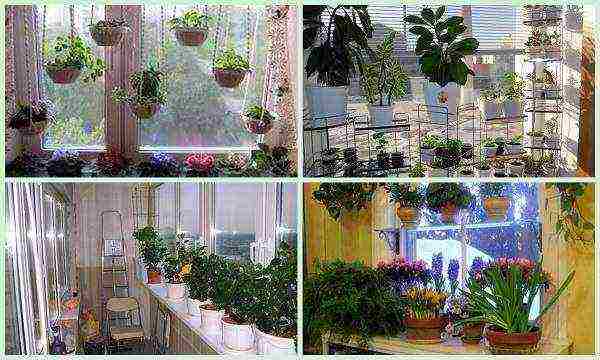
Ways of placing flowers in the house
- Normal air humidity - when the air is dry, spider mites start on the flowers, and excess moisture causes gray mold and leaf nematodes.
Top dressing
It is important to feed correctly: from an excess of calcium, chlorosis appears on the leaves, and with an excess of nitrogen, plants lose their immunity and are affected by pests. Chrysanthemums, cyclamens and carnations must be fertilized with phosphorus or phosphorus-potassium compounds. They will reduce infestation by aphids, blackleg, rust, mold.
Land preparation
The land for planting garden houses can be of four varieties: leaf, humus, turf, peat. They are combined with each other and added to the mixture of moss, lime, ash, coal, sand as needed:
- Improvement of sod soils - sand (river or lake white).
- Giving lightness, friability, hygroscopicity - sphagnum moss. But before adding it to the ground, it must be properly ground into powder. But with whole moss, you can cover the soil in pots, right on top, so that moisture does not go into the heat.
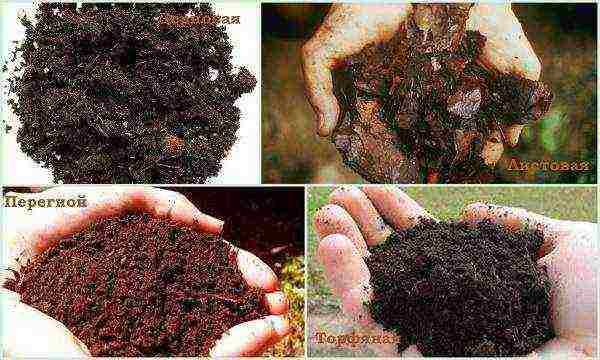
Four types of earth are mixed in suitable proportions
Young perennials require light soil - there should be a large percentage of leaf and peat soil in it. When they grow up, you need to move from leafy soil to soddy.
Another good option is garden soil, which is mixed with compost in a 2: 1 volume. You need to add sand and charcoal or sawdust to it.
Secrets of the correct transplant
It is necessary to transplant in a timely manner, as the plant grows.
See that there is no extra land that is not permeated with roots: such earthy lumps quickly turn sour, the whole earth deteriorates from them, and the plant itself dies. Therefore, when transplanting, increase the volume of the earth by no more than 1.5 cm.
You can water it with water, or you can make special infusions. For example, pour 1 kg of nettle with 10 liters of water, infuse the mixture for a couple of days and strain. Such water enhances the immunity of plants.
What to do in winter?
Winter is really a problem for garden plants, because in the world they are used to, there is no such season: they either sleep underground until spring, or they gave seeds and faded long ago. On the windowsill, they find themselves in "not at ease".
Therefore, to maintain their vegetative system, it is necessary to illuminate with 40 W fluorescent lamps. Luminescent options are much more economical.
If the window is cold, then another problem arises: the roots are dry due to the battery, and the foliage is cold due to the air on the windowsill. You need to either remove the plant from the window onto a table, a special stand, or shield the flower from cold and hot air with foil, agrofibre or other materials.
Beautiful flowers are an essential element of landscape design. They bring bright colors, give a feeling of summer and celebration, look great against the green background of the lawn and shrubs, and honey-bearing flowers are attractive to bees and butterflies. Decorating a garden with flower beds is a real creativity, and the expressiveness of a landscape composition depends on many important factors:
- correct scale (depending on the size of the site)
- proportionality, rhythm
- color harmony
The main principle of creating flower beds is the selection of groups of plants that are combined in height and shape of the bush, are equally demanding on the level of illumination (shade-tolerant, sun-loving), correspond to a certain color scheme: for a monochrome flower garden, plants with flowers of the same shade are selected, for contrasting - bright pairs ( e.g. blue and yellow flowers, blue and red.)
Color combination scheme
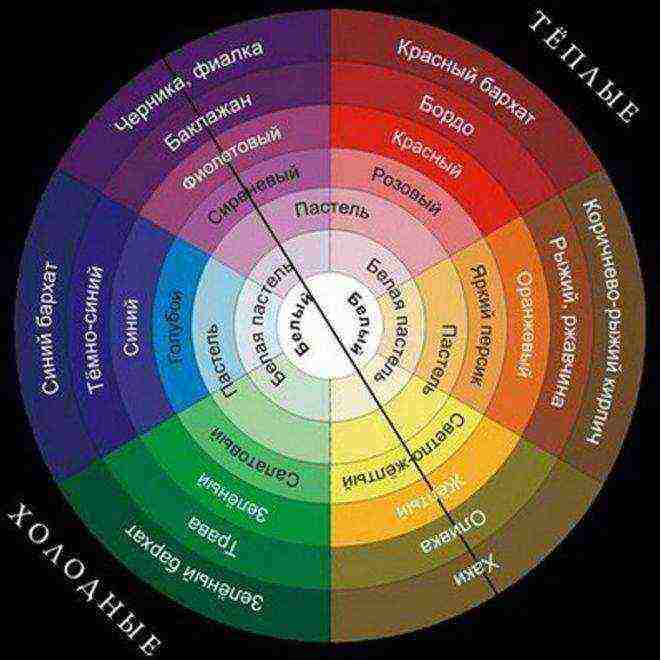
A color scheme
If you draw an equilateral triangle inside the scheme, then the colors that are at the top of the corners are combined brightly and contrastingly, even if the shades are pale. Opposite colors are also contrasting.
If you choose shades that lie side by side on a circle, you get a calm and discreet combination.
The type of flower garden in landscape design is largely determined by:
- the place where it is supposed to be placed,
- available area
- background (fence, lawn, house, and so on)
- point of view.
Types of flower beds
Rabatki are stripes of flowers 1-3 meters wide. Depending on the viewing angle and purpose, the ridges are:
- one-sided (the smallest plants are planted in the foreground, tall plants are planted in the background)
- bilateral (the tallest plants are planted in the middle)
- homogeneous (the whole space is filled with one type of biennial or annual flowers)
- ornamental (plants are planted in an artistic order, forming a certain repeating pattern)
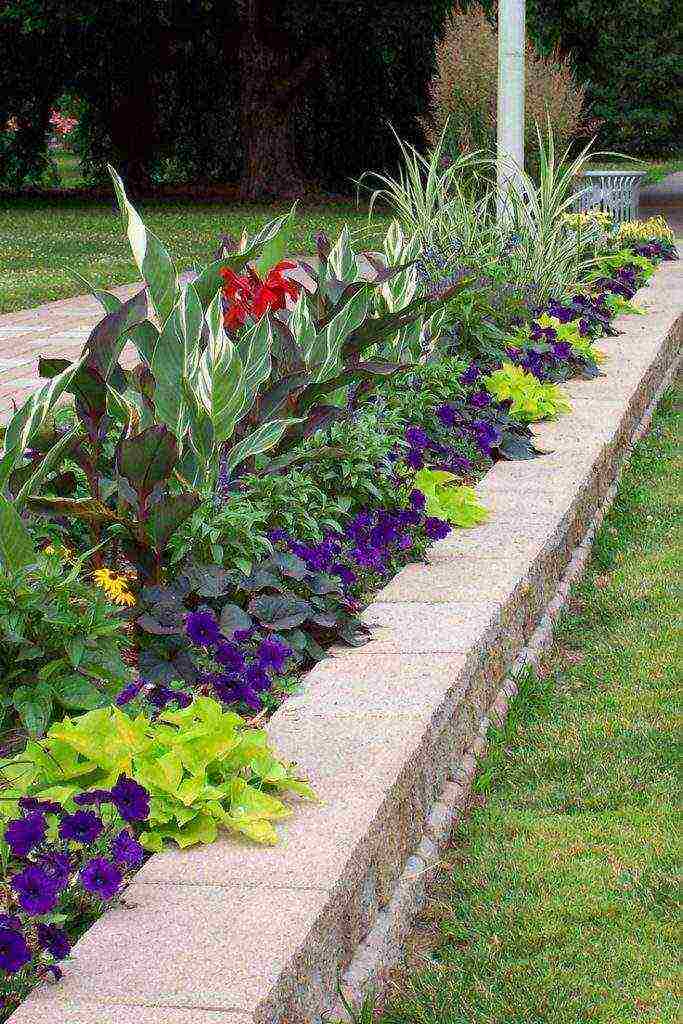
Double-sided collar
The border is a narrow strip of flowers 50-70 cm wide, which bloom continuously and remain highly decorative throughout the summer. The border of low-growing flowers for the garden looks beautiful, framing the paths against the background of the lawn.
Border
A flower bed - most often it is a flower garden of the correct shape, which has a fence.

Triangular flower bed
The parterre is a beautifully organized ceremonial space that includes a lawn, flower beds, rabatki, small architectural forms, paths, trimmed shrubs and trees.
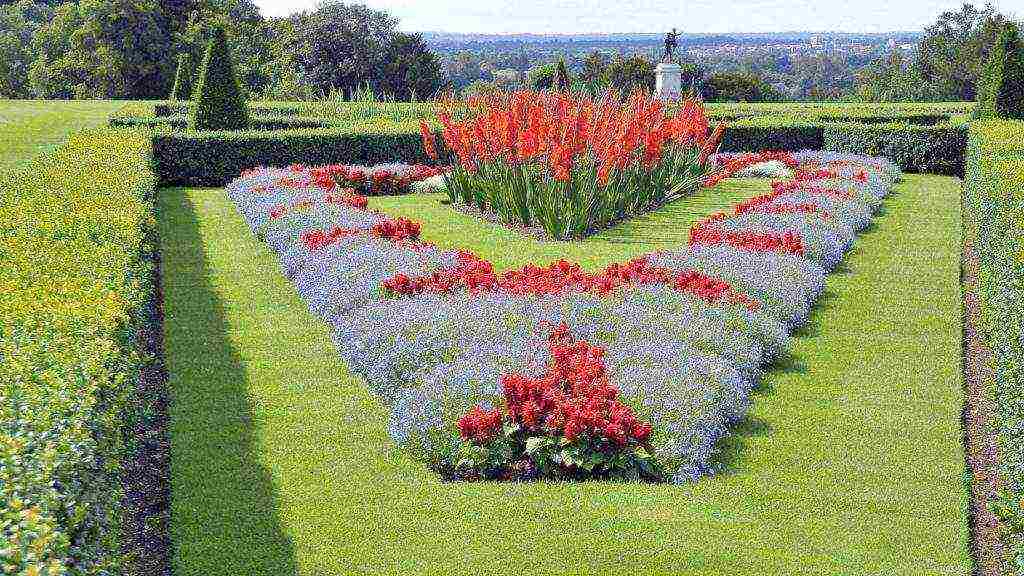
Parterre
A mixborder is a wide strip of plants (2 to 5 meters) with straight or curved contours. The basis of mixborders are perennial flowers, you can also use deciduous and coniferous shrubs, trees in the background. For continuous flowering, various bulbous and annuals are selected for them. Plants in a mixborder should be arranged in tiers so as not to obstruct, but to emphasize the dignity of each other. At the same time, flowering plants should be in harmony.

Mixborder
Rockery is created from stones and undersized ground cover plants. The hosts, creeping junipers, herbal cloves, various milkweed and rejuvenated look harmoniously in rockeries. Until the perennials grow, the empty space is filled with low-growing flowers for the garden.
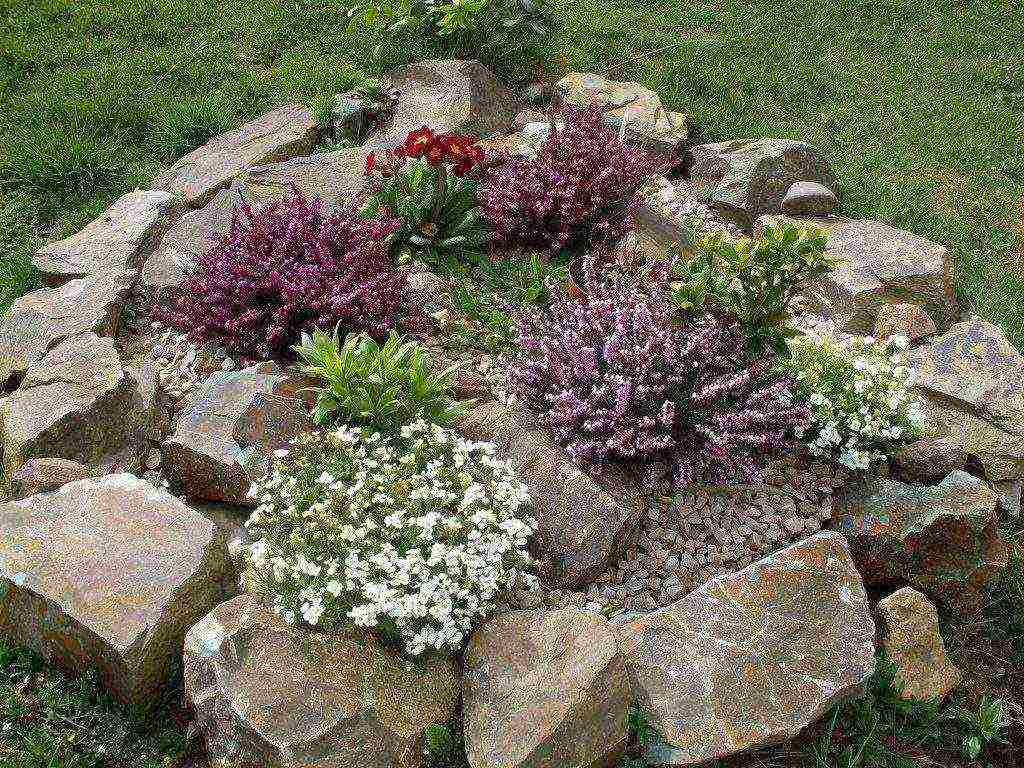
Rockery
Rock garden (alpine slide) - resembles a rockery, but, unlike it, is located not on a flat piece of land, but on a rocky embankment. Flowers and plants on the slopes of the rock garden are usually undersized.
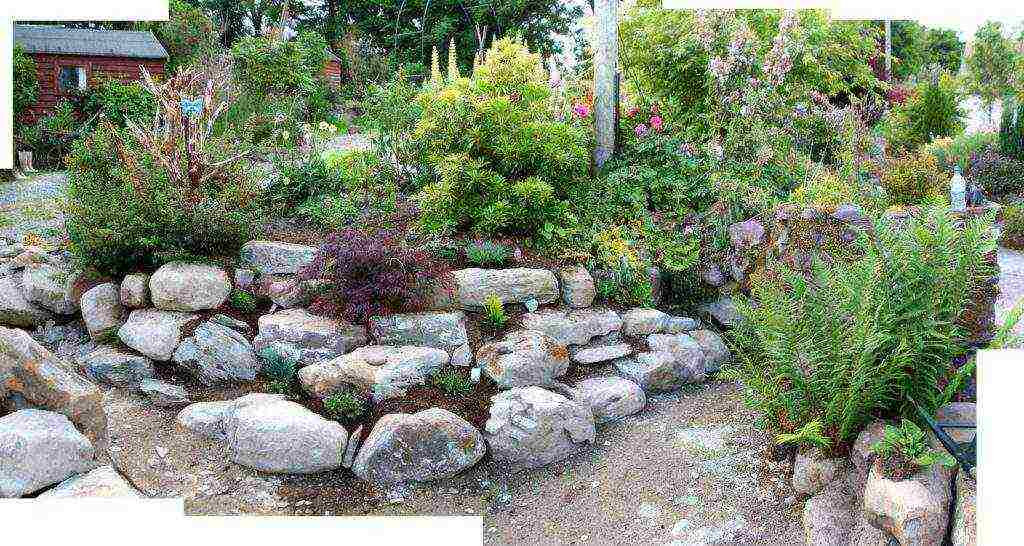
Rock garden
Flower garden of continuous flowering of perennials
A flower garden of free-form perennial plants requires the least care and attention, a real decoration of the garden. How to decorate it beautifully with your own hands?
To avoid mistakes, you must:
- make a list of plants with an indication of their flowering period (summer, autumn flowers or blooming all summer)
- draw a planting plan, taking into account the height and width of the bush of each instance
- mark a place for a flower garden on the site and evaluate it from the point of view of visibility and background
Spring flowering in the garden begins with the most popular perennial bulbous plants: these are unpretentious flowers that multiply quickly and easily. As a rule, small-bulbous (woodlands, quinodoxes, snowdrops, white flowers, crocuses, muscari) do not need to be dug after flowering, they must be planted only once every few years. The bulbs are planted in large groups, preferably at least 50 pieces, so that the flowers form a bright spot.

Crocuses are the first spring flowers
In addition to small-bulbous ones, tulips, daffodils, hazel grouses, decorative bows, pushkinia, hyacinths, primroses, hellebores, awl-shaped and splayed phlox, alpine forget-me-not delight with bright colors in spring.

Tulips and daffodils
Bulbs of tulips, daffodils, hyacinths, hazel grouses are planted in the fall, and after flowering they are dug up, dried, sorted and stored in a cool place until a new planting. Primroses, phloxes, hellebores and forget-me-nots are perennial rhizome plants, they are unpretentious and winter-hardy, bloom early and for a long time.

Hyacinths
Doronicum, gravilat, and dicentra bloom in May-June.
Summer bloom begins with irises of various shades.When planting irises, it must be borne in mind that they do not tolerate stagnant water and deepening of the root collar during planting.

Multicolored irises
In June, peonies, aquilegia, yaskolka, cyanosis, pyrethrum, aubrieta, oriental poppy, lychnis, lupins, evening primrose bloom. In July - lilies, carnations, gypsophila, delphiniums, daylilies, monarda, daisy, roses. In August and September, autumn flowers delight: asters, helenium, gladioli, loosestrife, paniculate phlox, echinacea, chrysanthemums.
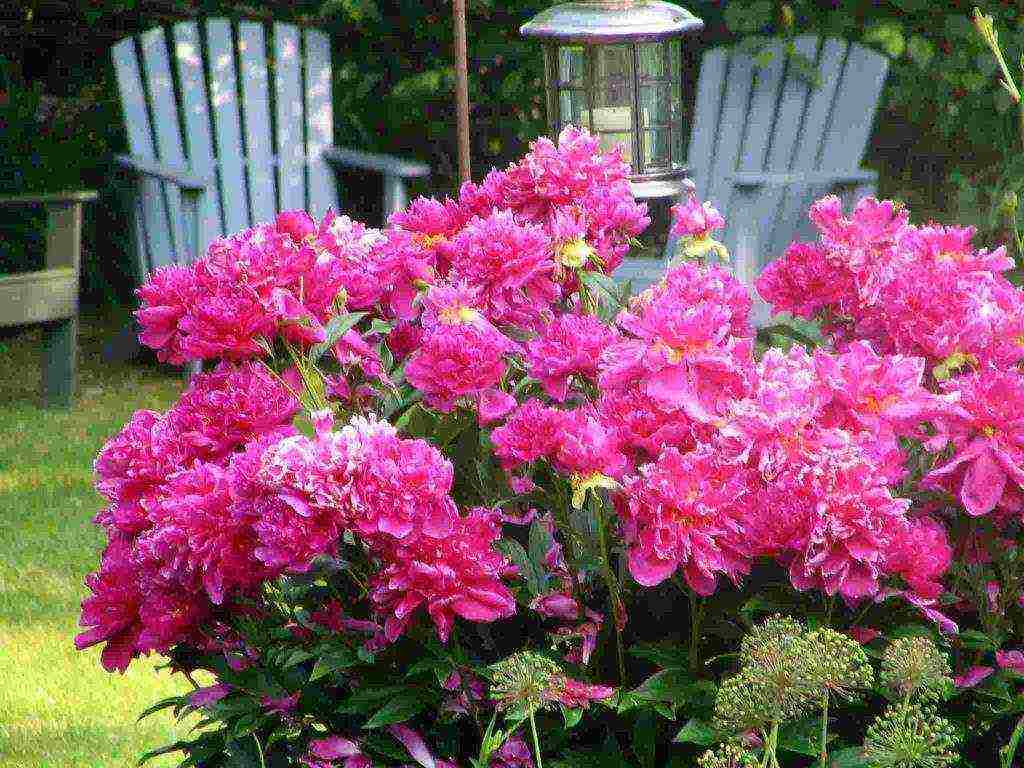
Terry peonies
The bright beauty of flowering plants is shaded by decorative deciduous perennials - hosts, geychera, brunner, ferns, tiarella, purse.
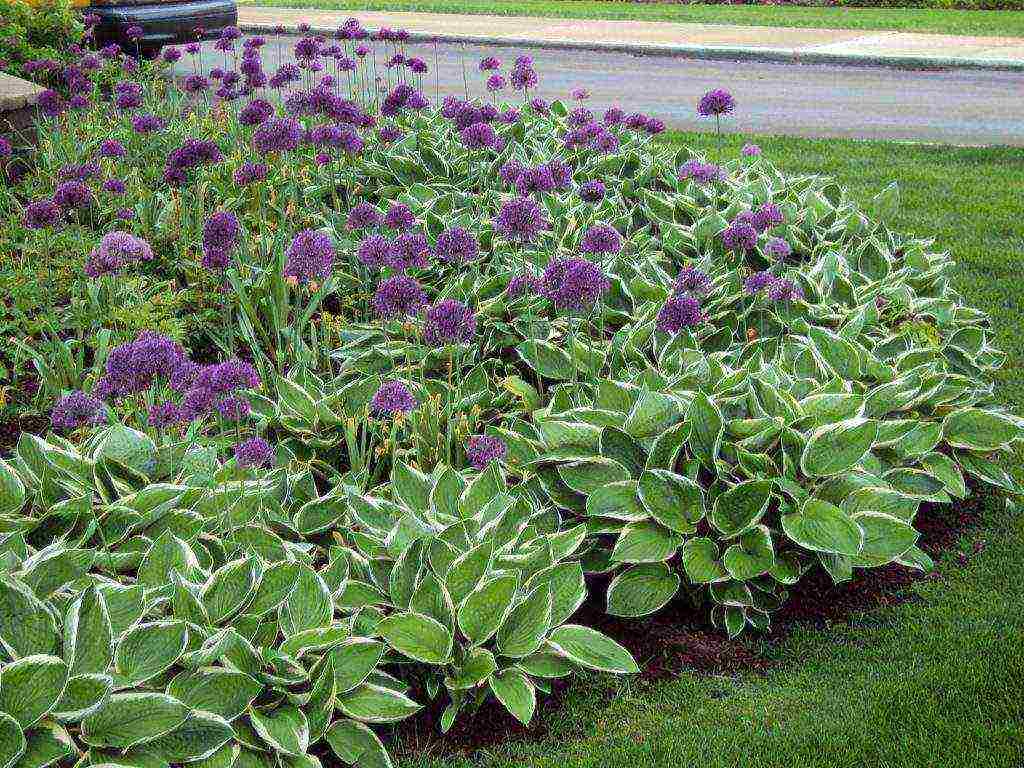
Hosts and decorative bow
When laying a flower garden, do not enclose it with a bright plastic fence and use a large amount of inert materials (painted pebbles or chips). Use stones (if it is not a rockery or alpine slide) and small architectural forms with care. Artificial materials often look unnatural against the background of fresh flowers and violate the harmony of the flower garden.
Flower garden
How to plant flowers
Preparing the soil for the flower garden. For planting flowers, the best soils are loamy and sandy loam. If the soil is heavy, then it must be removed, mixed with sand and peat, and at the bottom of the planting pit, make a drainage layer of crushed stone, expanded clay or broken brick. Most plants prefer slightly acidic or neutral soil, so if its acidity is increased, it is necessary to add deoxidizers (lime, dolomite flour). When laying a flower garden, rotted manure or compost is introduced. The ground level is raised by 5-10 cm so that after the soil shrinks, the flower garden does not appear below the level of the path or lawn, otherwise water will stagnate in it. Flowers are planted in planting holes or furrows with a large planting area.
Planting perennial plants. Perennial plants can be planted in the ground with green cuttings, rooted cuttings, rhizomes, seeds.
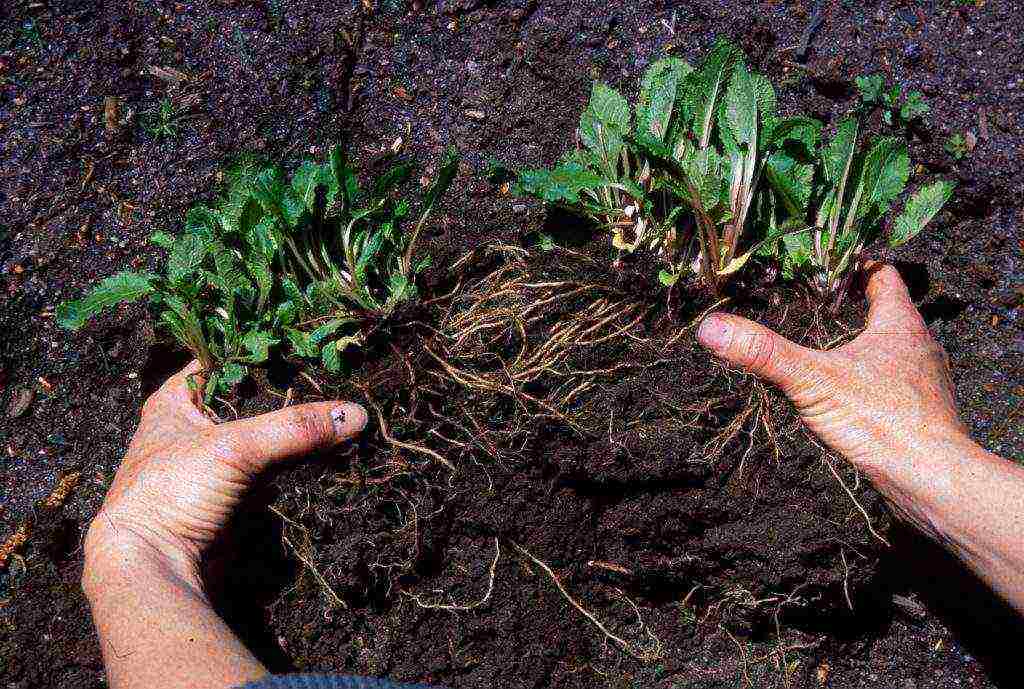
Dividing a plant for planting
Planting of plants should start from the middle of the flower garden to its edges, border low-growing flowers are planted last. Planting material of one type should be uniform (for example, only cuttings or only seedlings).
When buying rhizomes in early spring, it is advisable to choose those that have awakened buds. If it is too early to plant the plant in the garden, it is stored in the refrigerator, covering the roots with wet sawdust. You can plant a rhizome with a sprout in a pot before the onset of warm days, providing it with good lighting.
It is necessary to plant perennials taking into account their adult habit so that the flower garden does not look empty at the same time - annual flowers are planted between perennials, which are then removed.
Spring-flowering rhizome and bulbous plants are planted in autumn, the rest - in late summer, autumn or spring. After planting, the plants are watered and subsequently monitored for soil moisture.
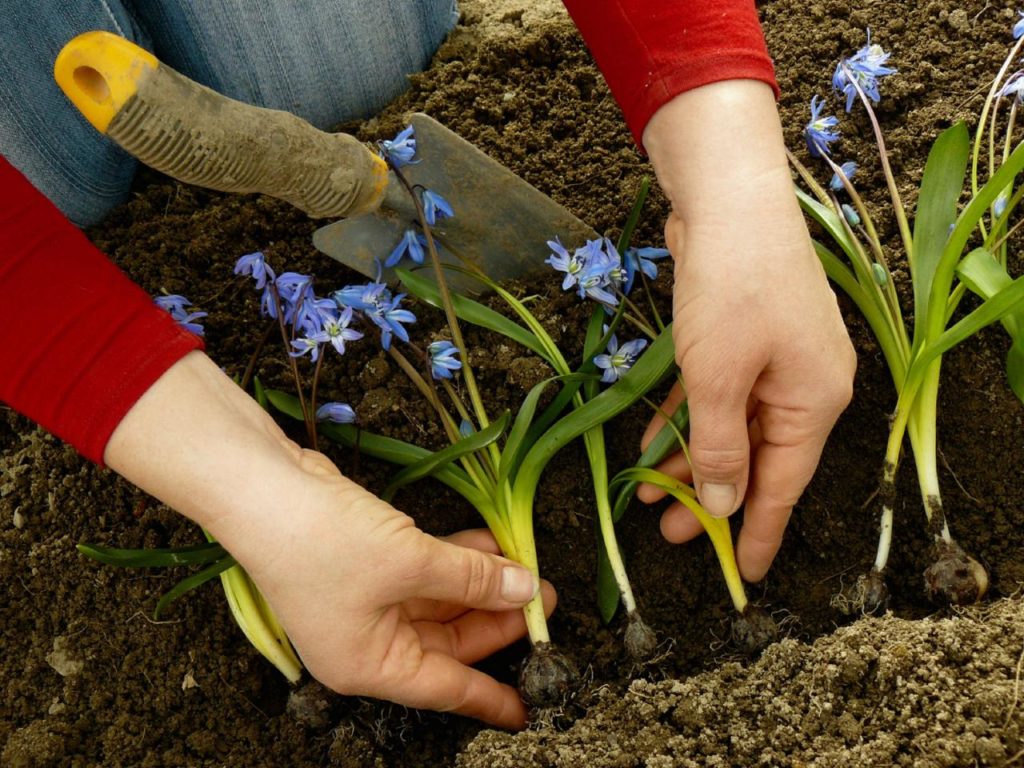
Snowdrop transplant
Planting annuals. If perennial plants are more suitable for creating mixborders, then flowering and decorative leafy summer flowers are irreplaceable for ridges and borders.
Annual plants are planted in the ground with seedlings or seeds. As a rule, seedlings are indispensable when growing petunia, gatsania, verbena, aster, levkoy, zinnia, celosia, lobelia. Unpretentious fast-growing eschscholzia, marigolds, nasturtium, cosmea, calendula are sown with seeds directly into the ground.
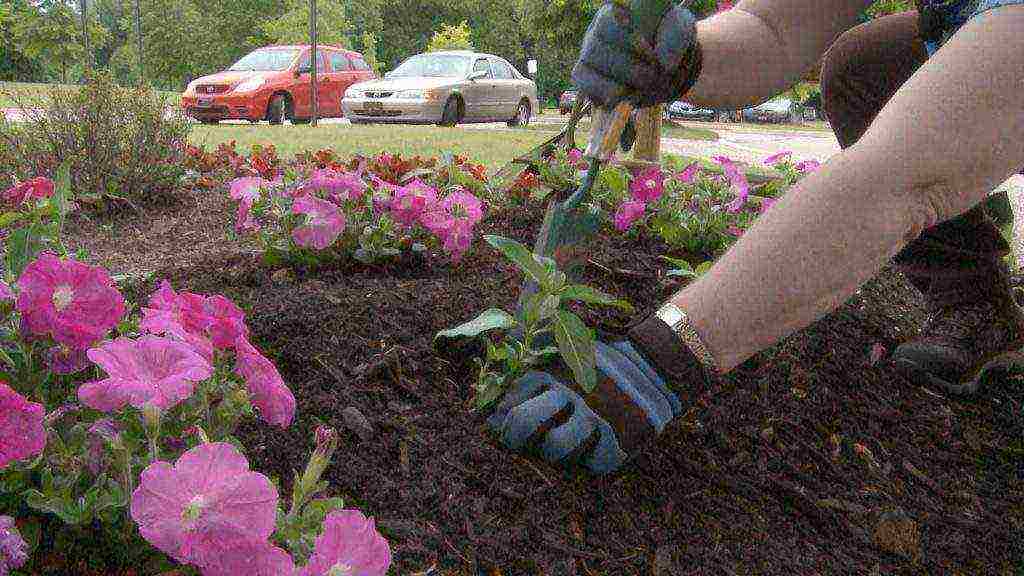
Planting petunias
The soil for sowing summer plants is prepared in the fall - they dig up, carefully removing the rhizomes of perennial weeds. In the spring it is leveled with a rake, watered well and lightly rolled. Small seeds are sown superficially, sprinkling them with a thin layer of sand on top, larger ones are embedded in grooves to a depth of 1.5-2 cm. The plantings are regularly watered with a fine spray, thick seedlings are thinned so that the plants do not stretch out.
Caring for flowers in the garden
To make the flower garden happy all summer long, it needs regular care, which consists in watering, weeding, loosening and fertilizing the plants. In the spring, nitrogen is applied twice, with an interval of three weeks, under perennials, and during the budding period and in autumn - a complete complex fertilizer with an increased content of potassium and phosphorus.
When planting annuals that bloom all summer, the soil is usually well prepared and filled with organic fertilizers. If this was not done, then the feeding scheme is as follows: during the period of intensive growth, nitrogen is introduced, and when the buds are laid and flowering begins, they are fed with a complex fertilizer with a high content of phosphorus and potassium.
Some plants need pinching for better branching and lateral shoot formation. It is necessary to remove faded inflorescences and set seeds in time, since their presence reduces the flowering period and the number of new buds. You should not wait for the inflorescence to completely wither, it must be removed as soon as decorativeness begins to be lost.
Pinching the plant
In some plants, after a beautiful and spectacular flowering, the foliage turns yellow. It needs to be removed. Bulbs of tulips, daffodils, hazel grouses are dug up and dried.
Large tall plants or plants with a spreading aerial part are tied up so that they do not break or fall apart from the wind.
Conclusion
Decorative flowers for the garden are the most important part of the landscape that can uniquely decorate your garden. We briefly talked about what flowers to use for landscape design, how to combine them correctly, how to plant and how to care for them. We hope this will help you turn your ideas into interesting and original landscape solutions.
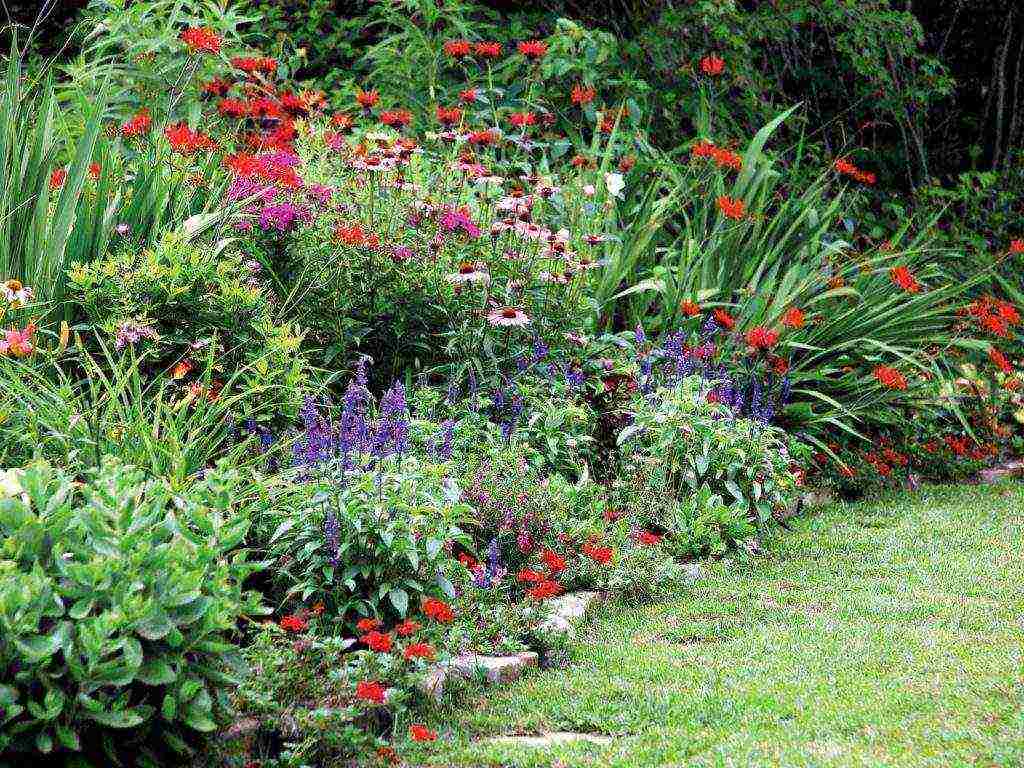
Perennial flower bed

